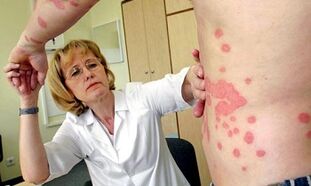
Non-communicable chronic disease, which, according to statistical data, affects several percent of the entire population, is psoriasis, the symptoms are manifested in the form of focal rashes, itching and intense exfoliation.
The disease can develop at any age and regardless of the social environment in which a person belongs. Psoriasis occurs equally in men and women. Often, the disease strikes young people under the age of twenty.
Many people are interested in the question: "Is itching in psoriasis, what are its symptoms and treatment, and most importantly, is it contagious? " Itching in psoriasis is found in almost 85% of cases, but the disease is not at all. contagious and non-contagious through airborne droplets or by means of households. It is difficult to treat, but complex therapies almost always give good results.
Manifestations of the disease
How is psoriasis manifested and what is this disease? Psoriatic plaques often develop first in areas with the most friction, such as elbows or knees.
Also, signs of psoriasis can appear on any area of the skin - head, face, back, abdomen, palms, feet, armpits and even genitals.
If we consider another similar disease - eczema, then it will affect the inside of the flexor surface, with psoriasis - the outside of the knee and elbow joints.
Pathology is chronic and has a wavy path, i. e. the condition of a person can improve under the influence of treatment methods or, conversely, worsen under the influence of negative factors, while remission and exacerbation are usually completely spontaneous.
Relapse can be caused by alcohol abuse, stress, infectious diseases. The severity of psoriasis varies from person to person, and even from the same person, throughout the course of the disease.

The main symptom of skin psoriasis is plaque, which appears as a small lesion in certain areas. In some cases, they can cover the entire body.
Psoriasis develops over time, especially if no appropriate steps are taken to correct it. The development of the disease consists of an increase in the period of exacerbation and an increase in the lesion area with the involvement of healthy skin areas in the inflammatory process. There are cases when the disease persists continuously without remission time.
Pathologies such as onychodystrophy - nail damage is very common. The disease can persist on its own, with no lesions on the skin. Also, psoriasis can contribute to the development of inflammatory processes in the joints - psoriatic arthritis (a disease of the small joints in the lower legs and arms), and onychodystrophy is observed in about 15% of patients with psoriasis.
There are many ways to overcome this disease, but due to the tendency of the disease to recur and worsen, psoriasis is very difficult to cure. Complete healing is almost impossible, that is, it is still done by a person until the end of his life, but with proper treatment and following all medical prescriptions, a longer remission period can be achieved.
Reason
Today, medicine does not know the true cause of this pathology, but it has been proven that damage to the immune system, neurological disorders and metabolic disorders can cause the disease. There are also a number of factors that can trigger the development of this disease:
- Genetic predisposition,in other words, is of moderate descent. Experts say that signs of psoriasis can be found in people whose blood relatives suffer from psoriasis. Moreover, if one parent is sick, the risk of getting the disease increases to 20%, and if both parents are sick, up to 50%. This is due to the presence of certain genes responsible for the development of dermatological changes. The first signs of hereditary psoriasis appear, as a rule, before 25 years.
- Neurological disorders.All emotional shocks, nervous tension, chronic fatigue can lead to the development of the disease. In addition, in people suffering from psoriasis, depressed conditions can lead to worsening disease.
- Hormonal failure.All pathological changes in the function of the organs of the endocrine system can trigger the mechanism of development of the disease.
- Violations of metabolic processes.Metabolic disorders associated with a lack of beneficial trace elements and vitamins in the body can cause psoriasis.
- Helminthic invasion.Some types of parasites can cause disease. Numerous laboratory studies have been conducted, the results show that many patients with psoriasis are infected with giardiasis, opisthorchiasis, ascariasis, enterobiasis. The problem is that in the process of their vital activity, helminths release toxic substances that poison the whole body. This leads to an increase in chronic disease and a significant decrease in immunity.
- A viral infection,that also attacks the human immune system.
From the above, it becomes clear that the process of psoriasis development, one way or another, is associated with disruption in the work of the body's defense mechanisms. Psoriasis on the body can develop under the influence of the whole trigger, or under the influence of factors such as unbalanced diet, climate change, alcohol abuse, and smoking.
Clinical description and types of psoriasis
How does psoriasis start? The first symptoms of the disease are the appearance of reddish plaques and itchy scaly patches that resemble lichen. Over time, the spots peel off, and a denser scaly layer is found beneath it.
As the disease progresses, the so-called Kenber phenomenon will be observed, as plaques appear in areas of skin trauma (with cuts, sores, burns).
Variety
There are several types of psoriasis, each of which has a specific clinical picture:
- Plaque (true psoriasis)is the most common form of the disease, occurring in more than 80% of all patients. The skin becomes inflamed, dry and thickened, with a high surface on it, covered with light silvery scales. The skin in these areas is hot to the touch and constantly exfoliates. After exfoliation, a reddish inflammatory focus is found, which is often damaged and bleeding. Inflammation can combine into a major focus. With psoriasis on the elbows and knees, the exfoliation is less noticeable.
- Tear-shaped- there is a lot of small dry inflammation with a red or purple round shape, rising above the surface of the skin. Psoriasis guttate covers a large part of the body. The first signs of the disease may occur after a previous sore throat or pharyngitis, caused by a streptococcal infection.
- Pustularis the most difficult form of the disease. It looks like the blister rash focus on a healthy skin surface. These bubbles are filled with exudates. Around the pustule, the skin becomes red, swollen, thickened and subsequently exfoliates. When a secondary infection persists, the blisters are filled with purulent fluid. Usually, this psoriasis is limited and affects certain areas, such as the lower leg and forearm. In severe cases, the inflammation begins to spread further on the surface of the skin, and the rash spots merge into one focus.
- Psoriatic arthritis- joints and connective tissue involved in pathological processes. The main manifestation of this form is severe itching. In addition, the skin of the joints on the fingers becomes sore, swollen, flaky and flaky.
- Onychodystrophy (nail psoriasis)can look like mycosis. With such diseases, the appearance of the nails changes, they become brittle and flaky, the color of the nail bed and the plate itself can change to yellow or gray. Also, white spots, dots and transverse lines appear on the nails and under the nails. The skin under and around the nails becomes firm. Often, onychodystrophy causes nail loss.
Additional symptoms of psoriasis include:
- bleeding lesions (at the site of skin trauma);
- nail erosion;
- severe itching;
- fever, swelling and joint pain in psoriatic arthritis (not always).
How the disease persists
There are several stages in the course of the disease:
- Progressive.This is the early stage of the disease. This is characterized by exacerbations, in which there is an increase in the number of new rashes.
- Not moving.At this stage, the picture of the disease does not change, i. e. the rash and other symptoms of psoriasis do not increase or decrease.
- Regression stage.The last stage of the disease, which persists without a rash.
Depending on the prevalence of the inflammatory process, the disease can be:
- limited- small areas of skin affected;
- normal- large areas of skin affected;
- generalized- almost the entire surface of the body is affected.
Among other things, psoriasis is considered a seasonal disease, that is, all symptoms worsen depending on the season. A large number of people generally get worse in winter or summer. In some patients, this process is not associated with seasonal changes.
Diagnostics

How is the disease diagnosed? The diagnosis of psoriasis is mainly based on examination by a dermatologist. Examination allows you to identify the form and extent of the lesion.
In some cases, differential diagnosis is made to differentiate psoriasis from other dermatological diseases. How to realize that the patient has this disease?
As already mentioned, in psoriasis, the Kenber phenomenon is observed, which does not exist in skin pathology. Another symptom should also be noted, when a light rim appears around the new papule, which has not yet begun to peel off - a kind of vascular reaction, which indicates the further development of the disease.
Sometimes skin biopsies are used to make a more accurate diagnosis, or tests performed can detect inflammatory processes in the blood. Once psoriasis is diagnosed, you should immediately begin treatment.
Treatment
Medicine
The main therapy is the use of topical preparations in the form of ointments, gels, creams and sprays.
These medicines contain ingredients that stop excess cell division in the skin and relieve unpleasant itching symptoms. A number of differentiated substances that are effective against this disease:
- Glucocorticoid hormone.They relieve inflammation and normalize the immune system.
- Vitamin D.The use of drugs with vitamin D will be most effective once the disease reaches a stable level, when the patient's condition is stable. Good results are obtained by taking such drugs in combination with ultraviolet irradiation procedures.
- Silicon.Improves skin condition, has the effect of absorbing and absorbing antigens involved in the development of this disease.
- Tarhas a beneficial effect on the inflammatory focus, which is localized in the head.
- Lecithin.Promotes rapid tissue regrowth. Preparations with this ingredient help the body cope with inflammation more quickly.
- Activated zincin a short time removes redness and relieves itching.
Patients are also given medications from the following groups:
- corticosteroids- normalizes metabolic processes;
- sitostatics- prevents cell division, but can weaken the body's defense mechanisms;
- immunomodulator- also regulates immune response, but its effectiveness is questionable;
- non-steroids- relieves inflammation and itching.
Vitamin complex is prescribed with this medicine.
Along with drug treatment, the following methods are very popular:
- Hirudotherapy.Leech therapy improves blood circulation and normalizes immune mechanisms.
- Cryotherapy.A special way of "freezing" relieves itching, swelling and inflammation.
- Ultraviolet radiation.This short-term procedure is combined with the introduction of special drugs.
Attention!Self-medication for psoriasis is unacceptable, as many medications have contraindications and are prescribed by a specialist only taking into account the individual physiological characteristics of the patient.

Children usually experience more severe psoriasis than adults, so local therapy gives good results, and even in case of exacerbation, repeated treatment allows you to achieve long-term remission.
Even if a child is diagnosed with a severe form, with timely treatment, the prognosis will be much better.
The main rule for parents is to know how to identify the symptoms of psoriasis and immediately start fighting the disease!
Traditional medicine
Traditional medicine recipes are often used to treat psoriasis. Compresses based on medicinal ingredients will be effective.
To prepare the compress, grind 4 tbsp. spoon of dried herbs and pour a glass of boiling water, then let it boil. In the broth, you need to moisten the gauze and apply on the sore spot.
The following plants have healing properties:
- calendula;
- ponytail;
- walnut leaves;
- celandine;
- yarrow;
- sweet clover;
- burdock;
- black currant leaves.
You can also prepare an oral tincture. For this, 1 tbsp. one tablespoon of dried herbs should be poured with a glass of boiling water, insist for 8 hours, strain and drink 100 ml twice a day, preferably half an hour before meals. Suitable for herbal collections:
- St. John's wort;
- celandine; order
- ;
- marshmallow;
- valerian.
Attention!Some of these ingredients can cause side effects, therefore, before starting treatment, you must familiarize yourself with all contraindications.

Medication ointment for home treatment is very popular. Here are some effective recipes:
- Bake the hips of dried roses and mix the ashes with petroleum jelly. Ointment should be applied to the affected area daily.
- Grind celandine leaves to 2 tbsp. spoon, add lanolin and petroleum jelly. Ointment to treat inflamed skin.
- Mix the series tingtur with lanolin and petroleum jelly and rub it into the psoriatic plaque.
- Grind meadowsweet roots, mix with oil or petroleum jelly, boil the resulting ointment, cool and burn sore spots.
Soothing herbal tea is beneficial. They can be made from motherwort, oregano, chamomile, mint, thyme, valerian, linden, peony.
Traditional medicine does not guarantee 100% results, it is better to combine it with the main treatment.
Psoriasis and pregnancy
Many women with psoriasis are in a state of anxiety about how the disease will occur during this period.
Psoriasis is an unpredictable disease, so it is difficult to answer the question: "How to determine the course of the disease during pregnancy". Symptoms of psoriasis may begin to develop, not move, or decrease. There are cases when after giving birth the disease disappears completely.
Every pregnant woman worries that the disease can be transmitted to her baby, but it is not the disease itself that is inherited, but only the tendency for it.

During breastfeeding, if the mother undergoes therapy with strong drugs, breastfeeding is very dangerous, because the substance can endanger the health of the baby. In this case, you need to stop treatment or transfer the baby to artificial foods.
The disease does not affect the conception and intrauterine development of the fetus, but medications taken by pregnant women can lead to negative consequences, so it is important to consult your doctor when planning a pregnancy, which will cancel some of them.
Prevention
The disease is unavoidable, but its manifestations can be significantly reduced. To achieve a reduction in the symptoms of the disease, you need to adhere to the following preventative rules:
- Try not to panic and learn to control your emotions. Natural sedatives can be used to ease this task.
- Reduce your intake of salty, smoked, spicy, fried and fatty foods, as well as honey, citrus fruits, chocolate and coffee.
- Wear clothes made of natural fabrics.
- Choose personal care products with low pH levels that will not dry out or irritate sore skin.
- Be careful with medications, as many of them can cause psoriasis, antibiotics are very dangerous.
- Quit smoking and alcohol.
- Avoid direct sunlight.
Psoriasis is one of the most common skin diseases, the nature of which is still not fully understood. The disease causes many difficulties, worsens the quality of life and lowers one's self-esteem.
It can happen suddenly and, unfortunately, no one is immune to the disease. That is why it is so important to know how this pathology manifests itself to consult a doctor in a timely manner and begin treatment.























